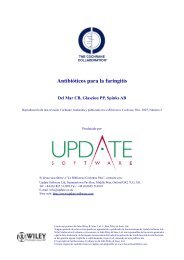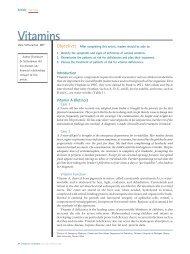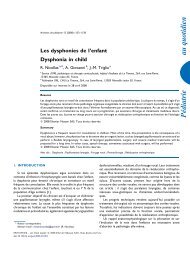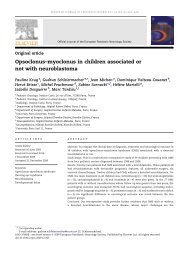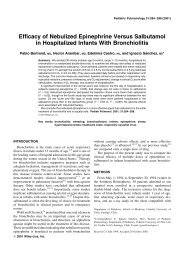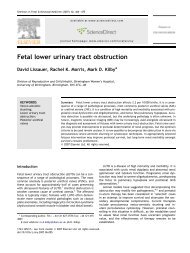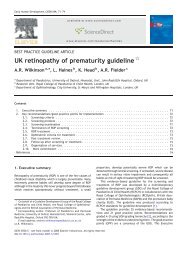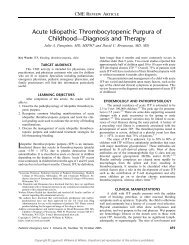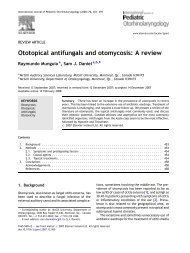Innate immune response to viral infection Cytokine - sepeap
Innate immune response to viral infection Cytokine - sepeap
Innate immune response to viral infection Cytokine - sepeap
You also want an ePaper? Increase the reach of your titles
YUMPU automatically turns print PDFs into web optimized ePapers that Google loves.
ARTICLE IN PRESS<br />
Cy<strong>to</strong>kine xxx (2008) xxx–xxx<br />
Contents lists available at ScienceDirect<br />
Cy<strong>to</strong>kine<br />
journal homepage: www.elsevier.com/locate/issn/10434666<br />
Review Article<br />
<strong>Innate</strong> <strong>immune</strong> <strong>response</strong> <strong>to</strong> <strong>viral</strong> <strong>infection</strong><br />
Shohei Koyama a,b , Ken J. Ishii a,c , Cevayir Coban a,b , Shizuo Akira a,b, *<br />
a Labora<strong>to</strong>ry of Host Defense, WPI Immunology Frontier Research Center, Osaka University, 3-1 Yamada-oka, Suita, Osaka 565-0871, Japan<br />
b Department of Host Defense, Osaka University, 3-1 Yamada-oka, Suita, Osaka 565-0871, Japan<br />
c Department of Molecular Pro<strong>to</strong>zoology, Research Institute for Microbial Diseases, Osaka University, 3-1 Yamada-oka, Suita, Osaka 565-0871, Japan<br />
article<br />
info<br />
abstract<br />
Article his<strong>to</strong>ry:<br />
Received 2 June 2008<br />
Accepted 9 June 2008<br />
Available online xxxx<br />
Keywords:<br />
Pattern recognition recep<strong>to</strong>rs<br />
Type I interferons<br />
Nucleic acids<br />
In <strong>viral</strong> <strong>infection</strong>s the host innate <strong>immune</strong> system is meant <strong>to</strong> act as a first line defense <strong>to</strong> prevent <strong>viral</strong><br />
invasion or replication before more specific protection by the adaptive <strong>immune</strong> system is generated. In<br />
the innate <strong>immune</strong> <strong>response</strong>, pattern recognition recep<strong>to</strong>rs (PRRs) are engaged <strong>to</strong> detect specific <strong>viral</strong><br />
components such as <strong>viral</strong> RNA or DNA or <strong>viral</strong> intermediate products and <strong>to</strong> induce type I interferons<br />
(IFNs) and other pro-inflamma<strong>to</strong>ry cy<strong>to</strong>kines in the infected cells and other <strong>immune</strong> cells. Recently these<br />
innate <strong>immune</strong> recep<strong>to</strong>rs and their unique downstream pathways have been identified. Here, we summarize<br />
their roles in the innate <strong>immune</strong> <strong>response</strong> <strong>to</strong> virus <strong>infection</strong>, discrimination between self and <strong>viral</strong><br />
nucleic acids and inhibition by virulent fac<strong>to</strong>rs and provide some recent advances in the coordination<br />
between innate and adaptive <strong>immune</strong> activation.<br />
Ó 2008 Published by Elsevier Ltd.<br />
1. Introduction<br />
* Corresponding author. Address: Labora<strong>to</strong>ry of Host Defense, WPI Immunology<br />
Frontier Research Center, Osaka University, 3-1 Yamada-oka, Suita, Osaka 565-<br />
0871, Japan. Fax: +81 6 6879 8305.<br />
E-mail address: sakira@biken.osaka-u.ac.jp (S. Akira).<br />
All living organisms have developed several kinds of mechanisms<br />
<strong>to</strong> protect themselves from invasion by exogenous microorganisms,<br />
including viruses. Although the production of neutralizing antibodies<br />
and activation of cy<strong>to</strong><strong>to</strong>xic T lymphocytes (CTL) or natural killer<br />
(NK) cells are essential for a specific and effective anti<strong>viral</strong> <strong>immune</strong><br />
<strong>response</strong>, other host cells also possess some <strong>immune</strong> mechanism <strong>to</strong><br />
prevent <strong>viral</strong> <strong>infection</strong>.<br />
Although multiple cy<strong>to</strong>kines and chemokines are produced by<br />
several kinds of host cells in <strong>viral</strong> <strong>infection</strong>, type I IFNs are the principal<br />
cy<strong>to</strong>kines involved in the anti<strong>viral</strong> <strong>response</strong>. Type I IFNs<br />
include multiple IFN-a isoforms, a single IFN-b, and other members,<br />
such as IFN-e, -j, -x and so on [1]. In contrast <strong>to</strong> type II IFN<br />
(IFN-c), which is exclusively produced by T cells and NK cells, type<br />
I IFNs can be produced by all nucleated cells in <strong>response</strong> <strong>to</strong> virus<br />
<strong>infection</strong>. Type III IFNs, comprised of IFN-k1, k2 and k3, have also<br />
recently been identified [2]. These IFNs each have different recep<strong>to</strong>rs<br />
but share downstream signaling molecules and regulate the<br />
same genes. IFNs have pleiotropic functions. They increase the<br />
expression of intrinsic proteins including TRIM5a, Fv, Mx, eIF2a<br />
and 2 0 –5 0 OAS, and induce apop<strong>to</strong>sis of virus-infected cells and cellular<br />
resistance <strong>to</strong> <strong>viral</strong> <strong>infection</strong> [3]. In addition they activate NK<br />
cells and dendritic cells (DC) and induce the activation of the adaptive<br />
<strong>immune</strong> system [4]. The expression of type I IFN and cy<strong>to</strong>kine<br />
genes is regulated by an intracellular signaling pathway that is<br />
activated by germline-encoded PRRs. These recep<strong>to</strong>rs recognize<br />
molecular patterns specific <strong>to</strong> microorganisms, such as <strong>viral</strong> genome<br />
nucleic acids. Nucleic acids such as DNA and RNA are essential<br />
components of all living organisms, so discrimination between self<br />
and non-self nucleic acids is essential especially in virus <strong>infection</strong>.<br />
Recent advances in research in<strong>to</strong> innate immunity have revealed<br />
that this discrimination relies, <strong>to</strong> a great extent, on PRRs including<br />
Toll-like recep<strong>to</strong>rs (TLRs), retinoic acid-inducible gene I (RIG-I)-like<br />
recep<strong>to</strong>rs (RLRs), and nucleotide-binding oligomerization domain<br />
(NOD)-like recep<strong>to</strong>rs (NLRs). Here, we review the current understanding<br />
of innate <strong>immune</strong> recognition of viruses and discrimination<br />
between self and <strong>viral</strong> nucleic acids, and provide some<br />
recent advances in coordination between innate <strong>immune</strong> signaling<br />
and adaptive <strong>immune</strong> activation.<br />
2. <strong>Innate</strong> <strong>immune</strong> recep<strong>to</strong>rs for virus sensing<br />
2.1. Endosomal TLRs in DCs<br />
Several kinds of viruses utilize host endocytic pathways at the<br />
cell entry phase or budding, so they are inevitably surveyed by<br />
endosomal innate <strong>immune</strong> sensors. Endosomal TLRs, including<br />
TLR3, TLR7, TLR8 and TLR9, share the property of being activated<br />
by nucleic acids. Their expression can be increased by type I IFNs<br />
but their distribution is restricted. TLR7 and TLR9 are highly<br />
expressed in plasmacy<strong>to</strong>id DCs (pDCs) which are expert cells<br />
known <strong>to</strong> produce a large amount of type I IFNs in <strong>response</strong> <strong>to</strong><br />
1043-4666/$ - see front matter Ó 2008 Published by Elsevier Ltd.<br />
doi:10.1016/j.cy<strong>to</strong>.2008.07.009<br />
Please cite this article in press as: Koyama S et al., <strong>Innate</strong> <strong>immune</strong> <strong>response</strong> <strong>to</strong> <strong>viral</strong> <strong>infection</strong>, Cy<strong>to</strong>kine (2008), doi:10.1016/<br />
j.cy<strong>to</strong>.2008.07.009
ARTICLE IN PRESS<br />
2 S. Koyama et al. / Cy<strong>to</strong>kine xxx (2008) xxx–xxx<br />
virus <strong>infection</strong>. TLR3 is expressed more widely, but is mainly expressed<br />
on conventional DCs (cDCs) [5]. The function of TLR8 is<br />
not clearly known yet.<br />
Recently endoplasmic reticulum (ER) protein UNC93B1 turned<br />
out <strong>to</strong> be essential for trafficking of TLR7 and TLR9 from ER <strong>to</strong><br />
endosome [6], but what triggers this TLR-trafficking from ER <strong>to</strong><br />
endosome before <strong>viral</strong> recognition by TLRs remains <strong>to</strong> be elucidated.<br />
A recent report suggests that TLR-sorting <strong>to</strong> the ligand<br />
may utilize au<strong>to</strong>phagy, which is a cellular process for recycling<br />
cy<strong>to</strong>solic compartments and, in the case of pDC, eliminating exogenous<br />
pathogen. Although cy<strong>to</strong>plasmic vesicular somatitis viruses<br />
(VSV) in pDC are thought <strong>to</strong> be trapped by au<strong>to</strong>phagosome<br />
expressing ATG5 and detected by TLR7 in lysosomes for a type I<br />
IFN <strong>response</strong> [7], in non-<strong>immune</strong> cells ATG5 suppresses the type<br />
I IFN <strong>response</strong> by interaction with caspase recruitment domains<br />
(CARDs) presented by RIG-I and IFN-b promoter stimula<strong>to</strong>r-1<br />
(IPS-1) [8] (Fig. 1).<br />
2.2. Endosomal recognition of <strong>viral</strong> RNA by TLRs<br />
TLR7 recognizes several kinds of RNA viruses, including<br />
orthomyxoviruses in pDCs. TLR7 signals through a TIR domaincontaining<br />
adapter, myeloid differentiation fac<strong>to</strong>r 88 (MyD88).<br />
Upon exposure <strong>to</strong> its ligand, MyD88 forms a complex with interleukin-1-recep<strong>to</strong>r<br />
(IL-1R)-associated kinase-4 (IRAK-4), IRAK-1, tumor<br />
necrosis fac<strong>to</strong>r-recep<strong>to</strong>r associated fac<strong>to</strong>r 3 (TRAF3), TRAF6,<br />
Ikka and IRF-7 [9–11]. Following the formation of this signaling<br />
complex, IRF7 and nuclear fac<strong>to</strong>r-kappa B (NF-jB) are activated,<br />
which results in the production of type I IFNs and cy<strong>to</strong>kines (Fig. 1).<br />
TLR3 recognizes double-stranded (ds)RNA and triggers a signaling<br />
pathway via a TIR domain-containing adapter inducing IFN-b<br />
(TRIF) (also known as TICAM-1) [12,13]. TRIF associates with<br />
TRAF3 and TRAF6 via TRAF-binding motifs which exist in its N-terminal<br />
portion and also with recep<strong>to</strong>r interacting protein (RIP) 1<br />
and RIP3 via RIP homotypic interaction motif (RHIM) [14,15].<br />
TRAF6 and RIP1 activate NF-jB while TRAF3 activates TRAF family<br />
member-associated NK-jB activa<strong>to</strong>r (TANK)-binding kinase 1<br />
(TBK1) and inducible IjB kinase (IKK-i). Activation of these pathways<br />
triggers anti<strong>viral</strong> <strong>response</strong>s (Fig. 1). TLR3 also activates the<br />
phosphatidylinosi<strong>to</strong>l-3 kinase (PI3K) pathway [16]. Tyrosine phosphorylation<br />
of TLR3 induces PI3K recruitment <strong>to</strong> the recep<strong>to</strong>r and<br />
subsequent activation of Akt leads <strong>to</strong> activation of IRF-3. TLR3<br />
plays an important role in the pathogenesis of RNA virus <strong>infection</strong>s<br />
in vivo. For example, TLR3 deficient mice are resistant <strong>to</strong> <strong>infection</strong><br />
Fig. 1. RNA sensing in virus <strong>infection</strong>. TLR3 recognizes dsRNA and triggers a signaling pathway via a TRIF. TRIF associates with TRAF3, TRAF6 and RIP1. TRAF6 and RIP1<br />
activate NF-kB and AP-1 while TRAF3 activates TBK1/IKK-i and is followed by a type I IFN <strong>response</strong>. Both RIG-I and MDA5 associate with an adapter protein IPS-1. IPS-1<br />
localizes on the outer mi<strong>to</strong>chondrial membrane and the CARD of it interacts with that of RIG-I or MDA5. IPS-1 associates with TRAF3 which induces the production of type I<br />
IFNs and FADD which induces activation of NF-kB. TLR7 signals through MyD88. MyD88 forms a complex with IRAK-4, IRAK-1, TRAF3, TRAF6, Ikka and IRF-7 and this complex<br />
is recruited <strong>to</strong> the TLR by ligand stimulation. Downstream of this signaling complex, IRF7 and NF-kB are activated and this is followed by the production of type I IFNs and<br />
cy<strong>to</strong>kines. ER protein UNC93B1 plays a key role in trafficking of TLR7 from ER <strong>to</strong> endosome, but the triggers are unknown. In the case of VSV recognition in pDC, the virus is<br />
trapped by au<strong>to</strong>phagosome expressing ATG5 and detected by TLR7 in the lysosome for production of a type I IFN <strong>response</strong>. Moreover in non-<strong>immune</strong> cells ATG5 suppresses<br />
the type I IFN <strong>response</strong> via RIG-I or IPS-1 inhibition. Yellow rectangles (TIR, CARD) indicate protein–protein interaction regions for downstream signaling.<br />
Please cite this article in press as: Koyama S et al., <strong>Innate</strong> <strong>immune</strong> <strong>response</strong> <strong>to</strong> <strong>viral</strong> <strong>infection</strong>, Cy<strong>to</strong>kine (2008), doi:10.1016/<br />
j.cy<strong>to</strong>.2008.07.009
ARTICLE IN PRESS<br />
S. Koyama et al. / Cy<strong>to</strong>kine xxx (2008) xxx–xxx 3<br />
with West Nile virus [17] and influenza virus [18]. In both cases<br />
inflamma<strong>to</strong>ry <strong>response</strong>s are decreased in TLR3 deficient mice,<br />
which suggests that an excess production of cy<strong>to</strong>kines is rather<br />
harmful for the survival of mice.<br />
2.3. Intracellular recognition of <strong>viral</strong> RNA by RLRs<br />
Recently, three homologous DExD/H box RNA helicases, RIG-I,<br />
melanoma differentiation-associated gene 5 (MDA5) and LGP2,<br />
were identified as cy<strong>to</strong>plasmic sensors of virus RNA, named here<br />
as RIG-like recep<strong>to</strong>rs (RLRs). RIG-I and MDA5 play a major role in<br />
recognition of RNA viruses in cDCs, macrophages and fibroblasts.<br />
RIG-I and MDA5 share two N-terminal CARDs followed by an<br />
RNA helicase domain [19] while LGP2 lacks a CARD. RIG-I binds<br />
5 0 -triphosphorylated single-stranded (ss)RNA [20] and short<br />
dsRNA [21] and stimulates production of type I IFNs. By contrast,<br />
MDA5 preferentially recognizes longer-dsRNA, including synthetic<br />
poly-IC [22]. RIG-I recognizes a variety of RNA viruses<br />
including influenza virus, VSV and Japanese encephalitis virus<br />
(JEV) while MDA5 recognizes picorna family such as encephalomyocarditis<br />
virus (EMCV), Theiler’s virus and Mengo virus [22].<br />
Therefore, RIG-I and MDA5 deficient mice are highly susceptible<br />
<strong>to</strong> VSV and EMCV, respectively. In addition it was indicated that<br />
the anti<strong>viral</strong> protein RNase L, which can cleave and turn a singlestranded<br />
portion of not only <strong>viral</strong> but also self RNA in<strong>to</strong> preferentially<br />
double-stranded form RNA, is a ligand for RIG-I and<br />
MDA5 [23].<br />
The CARDs of RIG-I and MDA5 are responsible for initiating the<br />
signaling pathway. Both RIG-I and MDA5 associate with an adapter<br />
protein IPS-1 also known as MAVS, VISA or CARDIF, which also<br />
contains an N-terminal CARD [24–27]. IPS-1 localizes on the outer<br />
mi<strong>to</strong>chondrial membrane. The IPS-1 CARD interacts with that of<br />
RIG-I or MDA5. IPS-1 then associates with TRAF3, followed by activation<br />
of TBK1 and Ikk-i. These kinases phosphorylate IRF3 and<br />
IRF7 and induce type I IFN production [28,29]. IPS-1 also interacts<br />
with Fas-associated death domain-containing protein (FADD) and<br />
leads <strong>to</strong> activation of NF-jB through cleavage of caspase-8/-10<br />
[30] (Fig. 1).<br />
2.4. Differential role of TLR and RLR in anti<strong>viral</strong> <strong>response</strong>s<br />
Occasionally both TLR and RLR are engaged for sensing the same<br />
dsRNA or ssRNA. Normally dsRNA does not exist in host cells but in<br />
virus <strong>infection</strong> it is detected as not only a <strong>viral</strong> structure but also as<br />
a byproduct of <strong>viral</strong> replication. dsRNA activates macrophages and<br />
dendritic cells via TLR3 <strong>to</strong> secrete pro-inflamma<strong>to</strong>ry cy<strong>to</strong>kines,<br />
especially IL-12. However, type-I IFNs are produced by virus-infected<br />
cells such as fibroblasts by TLR3 independently. MDA5 recognizes<br />
synthetic dsRNA, poly-IC, and the ssRNA virus, EMCV,<br />
which generates dsRNA during replication, and induces the type-I<br />
IFN <strong>response</strong> [22,31]. Poly-IC is neither capable of inducing an innate<br />
<strong>immune</strong> <strong>response</strong> nor of working as an adjuvant in TRIF/<br />
IPS-1 double knockout mice [32].<br />
In contrast <strong>to</strong> dsRNA, ssRNA abundantly exists not only in<br />
pathogens but also in host cells. ssRNA is recognized by TLR7<br />
(or TLR8 in humans) and RIG-I in a cell-type specific manner.<br />
Although TLR7 and TLR8 recognize GU of AU rich sequences of<br />
ssRNA viruses such as influenza virus and HIV, through TLR7<br />
expressing cells such as pDC, or TLR8 expressing cells such as<br />
myeloid DC or monocytes, it is unclear whether its sequence<br />
specificity is dependent on the recep<strong>to</strong>r or the cell [33]. In contrast<br />
<strong>to</strong> TLR7, RIG-I is expressed in most cell types. As described<br />
previously, RIG-I recognizes 5 0 -triphosphorylated ssRNA [20]. In<br />
the case of influenza A virus <strong>infection</strong>, its negative-sense ssRNA<br />
genome is recognized by TLR7 expressed in pDCs and a signal is<br />
transmitted through its adap<strong>to</strong>r protein MyD88 [34]. On the other<br />
hand, it is recognized by RIG-I ubiqui<strong>to</strong>usly expressed in most cell<br />
types, such as fibroblasts or cDCs in vitro [35], and probably by<br />
the alveolar macrophage in vivo [36], via its adap<strong>to</strong>r protein<br />
IPS-1. In mouse lungs after intranasal <strong>infection</strong> of influenza virus<br />
both TLR7/MyD88 and RIG-I/IPS-1 pathways concurrently control<br />
the type-I IFN <strong>response</strong> [37].<br />
2.5. Endosomal and intracellular recognition of <strong>viral</strong> DNA<br />
TLR9 recognizes unmethylated DNA with a CpG motif (CpG-<br />
DNA) and DNA viruses, including herpes simplex virus (HSV)-1,<br />
HSV-2 and cy<strong>to</strong>megalovirus (CMV) in pDCs. TLR9 shares the adapter<br />
protein MyD88 and the downstream signaling pathway with<br />
TLR7. cDCs and macrophages also respond <strong>to</strong> CpG-DNA and produce<br />
small amounts of IFN-b through IRF-1 activation rather than<br />
IRF-3 or IRF-7 activation [38].<br />
Recently, it was reported that genomic DNA of viruses, such as<br />
adenovirus, vaccinia virus and HSV [39–41], could be also recognized<br />
in a TLR9-independent manner, using an as yet unknown<br />
recognition mechanism in the cy<strong>to</strong>plasm [42,43]. In this case,<br />
DNA which has entered the cy<strong>to</strong>plasm activates the infected cells<br />
via TBK1 and IRF3 [44]. Actually the source of DNA is not restricted<br />
<strong>to</strong> viruses; but it can also come from bacteria and damaged host<br />
cells. The activity of this DNA is more potent in ds right-hand B-<br />
form DNA than in left-handed Z-form DNA, while ssDNA displays<br />
no activity [40,44,45] (Fig. 2). In addition DAI (also known as<br />
ZBP1 or DLM1) which contains two Z-DNA binding domains, was<br />
shown <strong>to</strong> be a potential cy<strong>to</strong>plasmic DNA sensor [46]. However,<br />
DAI KO mice induced a normal type I IFN <strong>response</strong> in vitro and<br />
in vivo after B-DNA stimulation and also indicated DNA-vaccine-induced<br />
adaptive <strong>immune</strong> <strong>response</strong>s, suggesting its role is redundant<br />
[47]. Potential cy<strong>to</strong>plasmic DNA sensors still remain <strong>to</strong> be<br />
elucidated.<br />
2.6. The recognition of <strong>viral</strong> components at the cell surface<br />
In addition <strong>to</strong> the endosomal TLRs, TLR2 and TLR4 have also<br />
been suggested <strong>to</strong> be involved in recognition of viruses. TLR2 has<br />
been shown <strong>to</strong> detect components of measles virus, HSV and hepatitis<br />
C virus (HCV) [48–50], while TLR4 produces a <strong>response</strong> <strong>to</strong> retrovirus<br />
and respira<strong>to</strong>ry syncytial virus (RSV) [51,52]. While <strong>viral</strong><br />
proteins recognized by these surface TLRs trigger pro-inflamma<strong>to</strong>ry<br />
<strong>response</strong>s, their contribution <strong>to</strong> either protective or pathological<br />
<strong>immune</strong> <strong>response</strong>s largely depends on the type of virus, route<br />
of <strong>infection</strong>, and other host fac<strong>to</strong>rs [53].<br />
2.7. NLRs mediates innate <strong>immune</strong> activation by intracellular <strong>viral</strong><br />
nucleic acids<br />
NLR proteins are comprised three motifs, C-terminal LRRs, central<br />
nucleotide-binding domain and N-terminal signaling domaincontaining<br />
CARDs, and Pyrin domain or baculovirus IAP repeats<br />
[54]. Cryopyrin/NALP3 was shown <strong>to</strong> recognize both ssRNA and<br />
dsRNA of <strong>viral</strong> origin or their synthetic versions and <strong>to</strong> induce caspase-1<br />
activation via apop<strong>to</strong>sis-associated speck-like protein containing<br />
a caspase-activating and recruitment domain (ASC)<br />
[55,56]. In addition, some NLRs participate in nucleic acid-mediated<br />
innate <strong>immune</strong> activation through caspase-1 activation<br />
[56,57], and NF-jB activation <strong>to</strong>wards IFN-I production via a synergistic<br />
pathway activated by NOD2 [58].<br />
3. Discrimination between self and <strong>viral</strong> nucleic acids<br />
The innate <strong>immune</strong> systems for virus sensing described above<br />
miraculously detect the invasion of pathogens such as viruses,<br />
Please cite this article in press as: Koyama S et al., <strong>Innate</strong> <strong>immune</strong> <strong>response</strong> <strong>to</strong> <strong>viral</strong> <strong>infection</strong>, Cy<strong>to</strong>kine (2008), doi:10.1016/<br />
j.cy<strong>to</strong>.2008.07.009
ARTICLE IN PRESS<br />
4 S. Koyama et al. / Cy<strong>to</strong>kine xxx (2008) xxx–xxx<br />
Fig. 2. DNA sensing in virus <strong>infection</strong>. TLR9 recognizes CpG-DNA and DNA viruses, including HSV-1, HSV-2 and CMV. TLR9 shares MyD88 and a downstream signaling<br />
pathway with TLR7 and ER protein UNC93B1 also plays a key role in trafficking of TLR9 from ER <strong>to</strong> endosome. In TLR9-independent DNA sensing, DNAs enter in<strong>to</strong> the<br />
cy<strong>to</strong>plasm which activates the infected cells via TBK1 and IRF3 but the recep<strong>to</strong>r and adap<strong>to</strong>r involved are still unknown. Their activities are more potent in ds right-hand B-<br />
form DNA than in left-handed Z-form DNA.<br />
but are silent in normal conditions. As dsRNA generated by <strong>viral</strong><br />
replication and virus DNA rich in CpG motifs are not normally<br />
found in our body, it is easy <strong>to</strong> consider that our innate <strong>immune</strong><br />
system recognizes them as foreign molecules. In contrast <strong>to</strong> these<br />
nucleic acids, ssRNA abundantly exists not only in pathogens but<br />
also in host cells. It is, therefore, essential for the host <strong>to</strong> detect<br />
and discriminate <strong>viral</strong> ssRNA from self ssRNA. However, the mechanism<br />
of this robust discrimination is not fully unders<strong>to</strong>od. For<br />
example, although the 5 0 triphosphate on many ssRNAs of viruses<br />
is absent from mRNA and transfer RNA but is found in ribosomal<br />
RNA, which abundantly exists in host cells, only the 5 0 triphosphate<br />
on viruses can induce RIG-I activation [59,60]. Recently RNase L<br />
activation in infected host cells was shown <strong>to</strong> generate small self<br />
RNAs which can induce an innate <strong>immune</strong> <strong>response</strong> via RLRs<br />
[61]. In addition, it is known that TLR7/8 and TLR9 also recognize<br />
host RNA and DNA. Therefore, it is necessary for absolute discrimination<br />
by the host innate <strong>immune</strong> system <strong>to</strong> recognize some additional<br />
fac<strong>to</strong>rs such as the methylation state, certain sequences and<br />
intracellular localization of RNA, or restricted endosomal expression<br />
of TLRs for <strong>viral</strong> recognition where host nucleic acids have limited<br />
access [62–64].<br />
4. Virulent fac<strong>to</strong>r for inhibition of host <strong>immune</strong> <strong>response</strong><br />
Viruses have developed several kinds of <strong>immune</strong> evasion strategies<br />
<strong>to</strong> proliferate within host cells. Their main target is the type I<br />
IFN <strong>response</strong>. Viruses can inhibit type I IFNs by many strategies i.e.<br />
inhibition of IFN synthesis, interference of IFN recep<strong>to</strong>r signaling<br />
and so on [65]. For example, vaccinia virus E3L and influenza virus<br />
NS1 which possess a dsRNA-binding site are thought <strong>to</strong> inhibit<br />
type I IFN production through dsRNA sequestration [66,67]. As<br />
E3L also possesses a DNA-binding site, it might sequester <strong>viral</strong><br />
DNA from host DNA sensing [68]. NS1 protein was also indicated<br />
<strong>to</strong> inhibit the function of IPS1 and RIG-I [69]. Viruses without such<br />
abilities <strong>to</strong> suppress the host type I IFN <strong>response</strong>s are generally low<br />
pathogenic and available for vaccine strains.<br />
5. Adaptive immunity against viruses through innate <strong>immune</strong><br />
signaling pathway<br />
Recent advances in the understanding of innate immunity show<br />
that the activation of the innate <strong>immune</strong> system is essential for<br />
subsequent adaptive <strong>immune</strong> <strong>response</strong>s including specific antibody<br />
production and CTL activation which play a key role in protection<br />
against virus <strong>infection</strong>. A recent report indicated that the<br />
adaptive <strong>immune</strong> <strong>response</strong> elicited by inactivated whole influenza<br />
virus vaccine containing <strong>viral</strong> ssRNA was strictly governed by the<br />
TLR7/MyD88 pathway, but not by the RIG-I/IPS-1 pathway,<br />
although both pathways concurrently controlled the innate <strong>immune</strong><br />
<strong>response</strong> [37]. However, the innate <strong>immune</strong> <strong>response</strong> elicited<br />
by a DNA vaccine containing CpG-DNA was dependent on<br />
TBK1, but not on the TLR9/MyD88 pathway [47]. These results sug-<br />
Please cite this article in press as: Koyama S et al., <strong>Innate</strong> <strong>immune</strong> <strong>response</strong> <strong>to</strong> <strong>viral</strong> <strong>infection</strong>, Cy<strong>to</strong>kine (2008), doi:10.1016/<br />
j.cy<strong>to</strong>.2008.07.009
ARTICLE IN PRESS<br />
S. Koyama et al. / Cy<strong>to</strong>kine xxx (2008) xxx–xxx 5<br />
gested that the innate <strong>immune</strong> pathway engaged for protective<br />
immunity against virus <strong>infection</strong> was different according <strong>to</strong> the<br />
source of antigen.<br />
6. Conclusion<br />
This review has illustrated the recent progress in understanding<br />
how a host discriminates between viruses and self components by<br />
innate <strong>immune</strong> recep<strong>to</strong>rs and elicits an inflamma<strong>to</strong>ry <strong>response</strong><br />
involving type I IFNs and other cy<strong>to</strong>kines. Much remains <strong>to</strong> be clarified<br />
about the complex interplay between host and virus, but elucidating<br />
such mechanisms in detail is essential for not only the<br />
development of a clinical approach such as nucleic acid-based<br />
immunotherapy and TLR based vaccine adjuvant but also the<br />
understanding of the pathogenesis of diverse <strong>viral</strong> diseases.<br />
Acknowledgments<br />
We thank members of Akira Labora<strong>to</strong>ry, Prof. Toshihiro Horii<br />
and his labora<strong>to</strong>ry members for discussions and contributions <strong>to</strong><br />
the work discussed here. This work was supported by grants from<br />
the Ministry of Education, Culture, Sports, Science and Technology<br />
in Japan.<br />
References<br />
[1] Stetson DB, Medzhi<strong>to</strong>v R. Type I interferons in host defense. Immunity<br />
2006;25:373–81.<br />
[2] Kotenko SV, Gallagher G, Baurin VV, Lewis-Antes A, Shen M, Shah NK, et al.<br />
IFN-lambdas mediate anti<strong>viral</strong> protection through a distinct class II cy<strong>to</strong>kine<br />
recep<strong>to</strong>r complex. Nat Immunol 2003;4:69–77.<br />
[3] Samuel CE. Anti<strong>viral</strong> actions of interferons. Clin Microbiol Rev<br />
2001;14:778–809.<br />
[4] Le Bon A, Tough DF. Links between innate and adaptive immunity via type I<br />
interferon. Curr Opin Immunol 2002;14:432–6.<br />
[5] Iwasaki A, Medzhi<strong>to</strong>v R. Toll-like recep<strong>to</strong>r control of the adaptive <strong>immune</strong><br />
<strong>response</strong>s. Nat Immunol 2004;5:987–95.<br />
[6] Kim YM, Brinkmann MM, Paquet ME, Ploegh HL. UNC93B1 delivers<br />
nucleotide-sensing <strong>to</strong>ll-like recep<strong>to</strong>rs <strong>to</strong> endolysosomes. Nature<br />
2008;452:234–8.<br />
[7] Lee HK, Lund JM, Ramanathan B, Mizushima N, Iwasaki A. Au<strong>to</strong>phagydependent<br />
<strong>viral</strong> recognition by plasmacy<strong>to</strong>id dendritic cells. Science<br />
2007;315:1398–401.<br />
[8] Jounai N, Takeshita F, Kobiyama K, Sawano A, Miyawaki A, Xin KQ, et al. The<br />
Atg5–Atg12 conjugate associates with innate anti<strong>viral</strong> <strong>immune</strong> <strong>response</strong>s. Proc<br />
Natl Acad Sci USA 2007;104:14050–5.<br />
[9] Häcker H, Redecke V, Blagoev B, Kratchmarova I, Hsu LC, Wang GG, et al.<br />
Specificity in Toll-like recep<strong>to</strong>r signalling through distinct effec<strong>to</strong>r functions of<br />
TRAF3 and TRAF6. Nature 2006;439:204–7.<br />
[10] Kawai T, Sa<strong>to</strong> S, Ishii KJ, Coban C, Hemmi H, Yamamo<strong>to</strong> M, et al. Interferonalpha<br />
induction through Toll-like recep<strong>to</strong>rs involves a direct interaction of<br />
IRF7 with MyD88 and TRAF6. Nat Immunol 2004;5:1061–8.<br />
[11] Uematsu S, Sa<strong>to</strong> S, Yamamo<strong>to</strong> M, Hirotani T, Ka<strong>to</strong> H, Takeshita F, et al.<br />
Interleukin-1 recep<strong>to</strong>r-associated kinase-1 plays an essential role for Toll-like<br />
recep<strong>to</strong>r (TLR)-7 and TLR9-mediated interferon-alpha induction. J Exp Med<br />
2005;201:915–23.<br />
[12] Yamamo<strong>to</strong> M, Sa<strong>to</strong> S, Mori K, Hoshino K, Takeuchi O, Takeda K, et al. Cutting<br />
edge: a novel Toll/IL-1 recep<strong>to</strong>r domain-containing adapter that preferentially<br />
activates the IFN-beta promoter in the Toll-like recep<strong>to</strong>r signaling. J Immunol<br />
2002;169:6668–72.<br />
[13] Oshiumi H, Matsumo<strong>to</strong> M, Funami K, Akazawa T, Seya T. TICAM-1, an adap<strong>to</strong>r<br />
molecule that participates in Toll-like recep<strong>to</strong>r 3-mediated interferon-beta<br />
induction. Nat Immunol 2003;4:161–7.<br />
[14] Sa<strong>to</strong> S, Sugiyama M, Yamamo<strong>to</strong> M, Watanabe Y, Kawai T, Takeda K, et al.<br />
Toll/IL-1 recep<strong>to</strong>r domain-containing adap<strong>to</strong>r inducing IFN-beta (TRIF)<br />
associates with TNF recep<strong>to</strong>r-associated fac<strong>to</strong>r 6 and TANK-binding kinase<br />
1, and activates two distinct transcription fac<strong>to</strong>rs, NF-kappa B and IFNregula<strong>to</strong>ry<br />
fac<strong>to</strong>r-3, in the Toll-like recep<strong>to</strong>r signaling. J Immunol<br />
2003;171:4304–10.<br />
[15] Meylan E, Burns K, Hofmann K, Blancheteau V, Martinon F, Kelliher M, et al.<br />
RIP1 is an essential media<strong>to</strong>r of Toll-like recep<strong>to</strong>r 3-induced NF-kappa B<br />
activation. Nat Immunol 2004;5:503–7.<br />
[16] Sarkar SN, Peters KL, Elco CP, Sakamo<strong>to</strong> S, Pal S, Sen GC. Novel roles of TLR3<br />
tyrosine phosphorylation and PI3 kinase in double-stranded RNA signaling.<br />
Nat Struct Mol Biol 2004;11:1060–7.<br />
[17] Wang T, Town T, Alexopoulou L, Anderson JF, Fikrig E, Flavell RA. Toll-like<br />
recep<strong>to</strong>r 3 mediates West Nile virus entry in<strong>to</strong> the brain causing lethal<br />
encephalitis. Nat Med 2004;10:1366–73.<br />
[18] Le Goffic R, Balloy V, Lagranderie M, Alexopoulou L, Escriou N, Flavell R, et al.<br />
Detrimental contribution of the Toll-like recep<strong>to</strong>r (TLR)3 <strong>to</strong> influenza A virusinduced<br />
acute pneumonia. PLoS Pathog 2006;2:e53.<br />
[19] Yoneyama M, Kikuchi M, Natsukawa T, Shinobu N, Imaizumi T, Miyagishi<br />
M, et al. The RNA helicase RIG-I has an essential function in doublestranded<br />
RNA-induced innate anti<strong>viral</strong> <strong>response</strong>s. Nat Immunol<br />
2004;5:730–7.<br />
[20] Pichlmair A, Schulz O, Tan CP, Naslund TI, Liljestrom P, Weber F, et al. RIG-Imediated<br />
anti<strong>viral</strong> <strong>response</strong>s <strong>to</strong> single-stranded RNA bearing 5 0 -phosphates.<br />
Science 2006;314:997–1001.<br />
[21] Takahasi K, Yoneyama M, Nishihori T, Hirai R, Kumeta H, Narita R, et al.<br />
Nonself RNA-sensing mechanism of RIG-I helicase and activation of anti<strong>viral</strong><br />
<strong>immune</strong> <strong>response</strong>s. Mol Cell 2008;29:428–40.<br />
[22] Ka<strong>to</strong> H, Takeuchi O, Sa<strong>to</strong> S, Yoneyama M, Yamamo<strong>to</strong> M, Matsui K, et al.<br />
Differential roles of MDA5 and RIG-I helicases in the recognition of RNA<br />
viruses. Nature 2006;441:101–5.<br />
[23] Malathi K, Dong B, Gale Jr M, Silverman RH. Small self-RNA generated by<br />
RNase L amplifies anti<strong>viral</strong> innate immunity. Nature 2007;448:816–9.<br />
[24] Kawai T, Takahashi K, Sa<strong>to</strong> S, Coban C, Kumar H, Ka<strong>to</strong> H, et al. IPS-1, an adap<strong>to</strong>r<br />
triggering RIG-I- and Mda5-mediated type I interferon induction. Nat<br />
Immunol 2005;6:981–8.<br />
[25] Seth RB, Sun L, Ea CK, Chen ZJ. Identification and characterization of MAVS, a<br />
mi<strong>to</strong>chondrial anti<strong>viral</strong> signaling protein that activates NF-kappaB and IRF 3.<br />
Cell 2005;122:669–82.<br />
[26] Meylan E, Curran J, Hofmann K, Moradpour D, Binder M, Bartenschlager R,<br />
et al. Cardif is an adap<strong>to</strong>r protein in the RIG-I anti<strong>viral</strong> pathway and is targeted<br />
by hepatitis C virus. Nature 2005;437:1167–72.<br />
[27] Xu LG, Wang YY, Han KJ, Li LY, Zhai Z, Shu HB. VISA is an adapter protein<br />
required for virus-triggered IFN-beta signaling. Mol Cell 2005;19:727–40.<br />
[28] Hemmi H, Takeuchi O, Sa<strong>to</strong> S, Yamamo<strong>to</strong> M, Kaisho T, Sanjo H, et al. The<br />
roles of two IkappaB kinase-related kinases in lipopolysaccharide and<br />
double stranded RNA signaling and <strong>viral</strong> <strong>infection</strong>. J Exp Med<br />
2004;199:1641–50.<br />
[29] Honda K, Yanai H, Negishi H, Asagiri M, Sa<strong>to</strong> M, Mizutani T, et al. IRF-7 is the<br />
master regula<strong>to</strong>r of type-I interferon-dependent <strong>immune</strong> <strong>response</strong>s. Nature<br />
2005;434:772–7.<br />
[30] Takahashi K, Kawai T, Kumar H, Sa<strong>to</strong> S, Yonehara S, Akira S. Roles of caspase-8<br />
and caspase-10 in innate <strong>immune</strong> <strong>response</strong>s <strong>to</strong> double-stranded RNA. J<br />
Immunol 2006;176:4520–4.<br />
[31] Gitlin L, Barchet W, Gilfillan S, Cella M, Beutler B, Flavell RA, et al. Essential role<br />
of mda-5 in type I IFN <strong>response</strong>s <strong>to</strong> polyriboinosinic:polyribocytidylic acid and<br />
encephalomyocarditis picornavirus. Proc Natl Acad Sci USA<br />
2006;103:8459–64.<br />
[32] Kumar H, Koyama S, Ishii KJ, Kawai T, Akira S. Cutting edge: cooperation of IPS-<br />
1- and TRIF-dependent pathways in poly IC-enhanced antibody production<br />
and cy<strong>to</strong><strong>to</strong>xic T cell <strong>response</strong>s. J Immunol 2008;180:683–7.<br />
[33] Diebold SS. Recognition of <strong>viral</strong> single-stranded RNA by Toll-like recep<strong>to</strong>rs.<br />
Adv Drug Deliv Rev 2008;60:813–23.<br />
[34] Diebold SS, Kaisho T, Hemmi H, Akira S, Reis e Sousa C. <strong>Innate</strong> anti<strong>viral</strong><br />
<strong>response</strong>s by means of TLR7-mediated recognition of single-stranded RNA.<br />
Science 2004;303:1529–31.<br />
[35] Ka<strong>to</strong> H, Sa<strong>to</strong> S, Yoneyama M, Yamamo<strong>to</strong> M, Uematsu S, Matsui K, et al. Cell<br />
type-specific involvement of RIG-I in anti<strong>viral</strong> <strong>response</strong>. Immunity<br />
2005;23:19–28.<br />
[36] Kumagai Y, Takeuchi O, Ka<strong>to</strong> H, Kumar H, Matsui K, Morii E, et al. Alveolar<br />
macrophages are the primary interferon-alpha producer in pulmonary<br />
<strong>infection</strong> with RNA viruses. Immunity 2007;27:240–52.<br />
[37] Koyama S, Ishii KJ, Kumar H, Tanimo<strong>to</strong> T, Coban C, Uematsu S, et al. Differential<br />
role of TLR- and RLR-signaling in the <strong>immune</strong> <strong>response</strong>s <strong>to</strong> influenza A virus<br />
<strong>infection</strong> and vaccination. J Immunol 2007;179:4711–20.<br />
[38] Schmitz F, Heit A, Guggemoos S, Krug A, Mages J, Schiemann M, et al.<br />
Interferon-regula<strong>to</strong>ry-fac<strong>to</strong>r 1 controls Toll-like recep<strong>to</strong>r 9-mediated IFN-beta<br />
production in myeloid dendritic cells. Eur J Immunol. 2007;37:315–27.<br />
[39] Nociari M, Ocheretina O, Schoggins JW, Falck-Pedersen E. Sensing <strong>infection</strong> by<br />
adenovirus: Toll-like recep<strong>to</strong>r-independent <strong>viral</strong> DNA recognition signals<br />
activation of the interferon regula<strong>to</strong>ry fac<strong>to</strong>r 3 master regula<strong>to</strong>r. J Virol<br />
2007;81:4145–57.<br />
[40] Ishii KJ, Coban C, Ka<strong>to</strong> H, Takahashi K, Torii Y, Takeshita F, et al. A Toll-like<br />
recep<strong>to</strong>r-independent anti<strong>viral</strong> <strong>response</strong> induced by double-stranded B-form<br />
DNA. Nat Immunol 2006;7:40–8.<br />
[41] Hochrein H, Schlatter B, O’Keeffe M, Wagner C, Schmitz F, Schiemann M, et al.<br />
Herpes simplex virus type-1 induces IFN-alpha production via Toll-like<br />
recep<strong>to</strong>r 9-dependent and -independent pathways. Proc Natl Acad Sci USA<br />
2004;101:11416–21.<br />
[42] Wagner H, Bauer S. All is not Toll: new pathways in DNA recognition. J Exp<br />
Med 2006;203:265–8.<br />
[43] Ishii KJ, Akira S. <strong>Innate</strong> <strong>immune</strong> recognition of, and regulation by, DNA. Trends<br />
Immunol 2006;27:525–32.<br />
[44] Stetson DB, Medzhi<strong>to</strong>v R. Recognition of cy<strong>to</strong>solic DNA activates an IRF3-<br />
dependent innate <strong>immune</strong> <strong>response</strong>. Immunity 2006;24:93–103.<br />
[45] Okabe Y, Kawane K, Akira S, Taniguchi T, Nagata S. Toll-like recep<strong>to</strong>rindependent<br />
gene induction program activated by mammalian DNA escaped<br />
from apop<strong>to</strong>tic DNA degradation. J Exp Med 2005;202:1333–9.<br />
[46] Takaoka A, Wang Z, Choi MK, Yanai H, Negishi H, Ban T, et al. DAI (DLM-1/<br />
ZBP1) is a cy<strong>to</strong>solic DNA sensor and an activa<strong>to</strong>r of innate <strong>immune</strong> <strong>response</strong>.<br />
Nature 2007;448:501–5.<br />
Please cite this article in press as: Koyama S et al., <strong>Innate</strong> <strong>immune</strong> <strong>response</strong> <strong>to</strong> <strong>viral</strong> <strong>infection</strong>, Cy<strong>to</strong>kine (2008), doi:10.1016/<br />
j.cy<strong>to</strong>.2008.07.009
ARTICLE IN PRESS<br />
6 S. Koyama et al. / Cy<strong>to</strong>kine xxx (2008) xxx–xxx<br />
[47] Ishii KJ, Kawagoe T, Koyama S, Matsui K, Kumar H, Kawai T, et al. TANKbinding<br />
kinase-1 delineates innate and adaptive <strong>immune</strong> <strong>response</strong>s <strong>to</strong> DNA<br />
vaccines. Nature 2008;451:725–9.<br />
[48] Bieback K, Lien E, Klagge IM, Avota E, Schneider-Schaulies J, Duprex WP, et al.<br />
Hemagglutinin protein of wild-type measles virus activates <strong>to</strong>ll-like recep<strong>to</strong>r 2<br />
signaling. J Virol 2002;76:8729–36.<br />
[49] Kurt-Jones EA, Chan M, Zhou S, Wang J, Reed G, Bronson R, et al. Herpes<br />
simplex virus 1 interaction with Toll-like recep<strong>to</strong>r 2 contributes <strong>to</strong> lethal<br />
encephalitis. Proc Natl Acad Sci USA 2004;101:1315–20.<br />
[50] Duesberg U, Von dem Bussche A, Kirschning C, Miyake K, Sauerbruch T,<br />
Spengler U. Cell activation by synthetic lipopeptides of the hepatitis C virus<br />
(HCV)–core protein is mediated by <strong>to</strong>ll like recep<strong>to</strong>rs (TLRs) 2 and 4. Immunol<br />
Lett 2002;84:89–95.<br />
[51] Kurt-Jones EA, Popova L, Kwinn L, Haynes LM, Jones LP, Tripp RA, et al. Pattern<br />
recognition recep<strong>to</strong>rs TLR4 and CD14 mediate <strong>response</strong> <strong>to</strong> respira<strong>to</strong>ry<br />
syncytial virus. Nat Immunol 2000;1:398–401.<br />
[52] Rassa JC, Meyers JL, Zhang Y, Kudaravalli R, Ross SR. Murine retroviruses<br />
activate B cells via interaction with <strong>to</strong>ll-like recep<strong>to</strong>r 4. Proc Natl Acad Sci USA<br />
2002;99:2281–6.<br />
[53] Finberg RW, Wang JP, Kurt-Jones EA. Toll like recep<strong>to</strong>rs and viruses. Rev Med<br />
Virol 2007;17:35–43.<br />
[54] Meylan E, Tschopp J, Karin M. Intracellular pattern recognition recep<strong>to</strong>rs in the<br />
host <strong>response</strong>. Nature 2006;442:39–44.<br />
[55] Kanneganti TD, Body-Malapel M, Amer A, Park JH, Whitfield J, Franchi L, et al.<br />
Critical role for Cryopyrin/Nalp3 in activation of caspase-1 in <strong>response</strong> <strong>to</strong> <strong>viral</strong><br />
<strong>infection</strong> and double-stranded RNA. J Biol Chem 2006;281:36560–8.<br />
[56] Kanneganti TD, Ozoren N, Body-Malapel M, Amer A, Park JH, Franchi L, et al.<br />
Bacterial RNA and small anti<strong>viral</strong> compounds activate caspase-1 through<br />
cryopyrin/Nalp3. Nature 2006;440:233–6.<br />
[57] Muruve DA, Petrilli V, Zaiss AK, White LR, Clark SA, Ross PJ, et al. The<br />
inflammasome recognizes cy<strong>to</strong>solic microbial and host DNA and triggers an<br />
innate <strong>immune</strong> <strong>response</strong>. Nature 2008;452:103–7.<br />
[58] Leber JH, Crimmins GT, Raghavan S, Meyer-Morse NP, Cox JS, Portnoy DA.<br />
Distinct TLR- and NLR-mediated transcriptional <strong>response</strong>s <strong>to</strong> an intracellular<br />
pathogen. PLoS Pathog 2008;4:e6.<br />
[59] Hornung V, Ellegast J, Kim S, Brzozka K, Jung A, Ka<strong>to</strong> H, et al. 5 0 -Triphosphate<br />
RNA is the ligand for RIG-I. Science 2006;314:994–7.<br />
[60] Ramakrishnan V. Ribosome structure and the mechanism of translation. Cell<br />
2002;108:557–72.<br />
[61] Malathi K, Dong B, Gale M, Silverman R. Small self-RNA generated by RNase L<br />
amplifies anti<strong>viral</strong> innate immunity. Nature 2007;448:816–9.<br />
[62] Kariko K, Buckstein M, Ni H, Weissman D. Suppression of RNA recognition by<br />
Toll-like recep<strong>to</strong>rs: the impact of nucleoside modification and the evolutionary<br />
origin of RNA. Immunity 2005;23:165–75.<br />
[63] Ishii KJ, Akira S. TLR ignores methylated RNA? Immunity<br />
2005;23:111–3.<br />
[64] Marshak-Rothstein A, Rifkin I. Immunologically active au<strong>to</strong>antigens: the role<br />
of <strong>to</strong>ll-like recep<strong>to</strong>rs in the development of chronic inflamma<strong>to</strong>ry disease.<br />
Annu Rev Immunol 2007;25:419–41.<br />
[65] Weber F, Kochs G, Haller O. Inverse interference: how viruses fight the<br />
interferon system. Viral Immunol 2004;17:498–515.<br />
[66] Xiang Y, Condit RC, Vijaysri S, Jacobs B, Williams BR, Silverman RH. Blockade of<br />
interferon induction and action by the E3L double-stranded RNA binding<br />
proteins of vaccinia virus. J Virol 2002;76:5251–9.<br />
[67] Garcia-Sastre A. Inhibition of interferon-mediated anti<strong>viral</strong> <strong>response</strong>s by<br />
influenza A viruses and other negative-strand RNA viruses. Virology<br />
2001;279:375–84.<br />
[68] Kim YG, Muralinath M, Brandt T, Pearcy M, Hauns K, Lowenhaupt K, et al. A<br />
role for Z-DNA binding in vaccinia virus pathogenesis. Proc Natl Acad Sci USA<br />
2003;100:6974–9.<br />
[69] Mibayashi M, Martinez-Sobrido L, Loo YM, Cardenas WB, Gale Jr M, Garcia-<br />
Sastre A. Inhibition of retinoic acid-inducible gene I-mediated induction of<br />
beta interferon by the NS1 protein of influenza A virus. J Virol<br />
2007;81:514–24.<br />
Please cite this article in press as: Koyama S et al., <strong>Innate</strong> <strong>immune</strong> <strong>response</strong> <strong>to</strong> <strong>viral</strong> <strong>infection</strong>, Cy<strong>to</strong>kine (2008), doi:10.1016/<br />
j.cy<strong>to</strong>.2008.07.009




